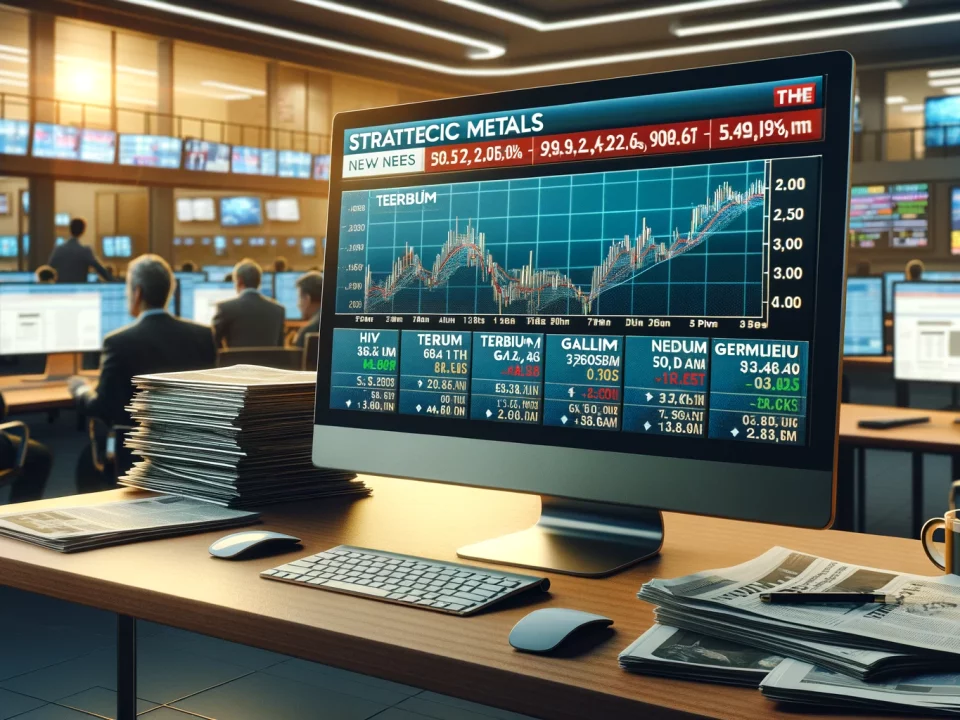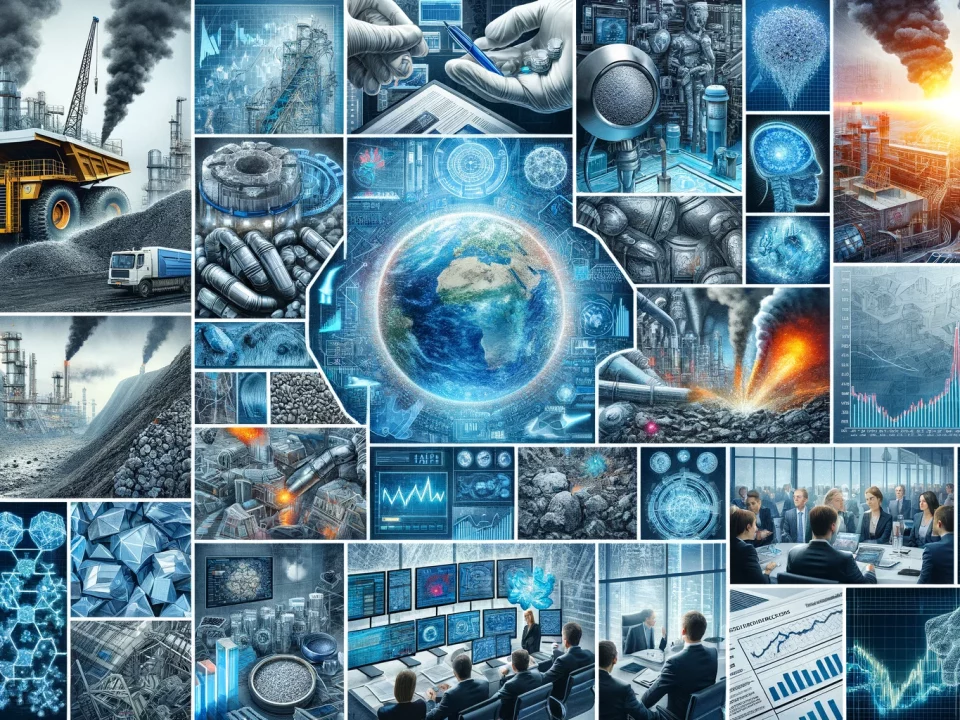
Weekly News Review Apr 1 – Apr 7 2024
April 7, 2024
Weekly News Review Apr 15 – Apr 21 2024
April 21, 2024Welcome to our weekly news review.
UNITED STATES INVESTS BILLIONS TO BOLSTER DOMESTIC SUPPLY CHAIN:
Chip makers will build new factories and expand existing ones in North America.
The U.S. Government is ramping up efforts to strengthen the domestic chip and semiconductor industry. On Monday, President Joe Biden announced a preliminary agreement with Taiwan Semiconductor Manufacturing Company (TSMC) to provide $6.6 billion in direct funding under the Chips and Science Act to expand its Arizona facilities. The sum makes up roughly ten percent of TSMC’s total investment in Arizona: the company announced it will add $25 billion to reach a staggering sum of $65 billion. The chipmaker also agreed to build a third factory in the state, which aims to produce the most advanced semiconductors in the U.S.
Government Also Set to Support Samsung’s Facilities in Texas –
In addition to TSMC, South Korean Samsung will also receive $6.6 billion, according to Reuters citing unnamed sources. As part of the agreement with the U.S. Government, the company will more than double its investment in the U.S., bringing it to over $44 billion. The money will reportedly go to four facilities in Texas, including a chipmaking plant announced in 2021 (we reported). The remaining three will be an additional chip manufacturing facility, a research center, and a packaging plant. The sources added that the Department of Commerce will announce the investment next week.
U.S. President Joe Biden signed the U.S. Chips and Science Act into law in 2022, providing $52.7 billion in financial support for domestic semiconductor research, development, and production. In addition, lawmakers approved $75 billion in government loans.
USA – INFLATION REDUCTION ACT: EUROPEAN CARMAKERS CONTINUE TO MISS OUT.
The E.U.-U.S. Trade and Technology Council meeting fails to reach an agreement.
European car manufacturers will still not benefit from the U.S. “Inflation Reduction Act” (IRA) subsidies. The sixth meeting of the EU-US Trade and Technology Council (TTC), which ended on Friday, has yet to progress. At the heart of the matter was a “Critical Minerals Agreement,” i.e., a raw materials agreement comparable to the U.S. free trade agreements with its neighbors Mexico and Canada.
Electric vehicles containing critical minerals extracted and processed in the E.U. would be eligible for funding under the IRA if such an agreement would be made.
Participants at the meeting emphasized that work on an agreement would continue. However, the TTC will not meet again until after the November presidential election in the USA, and Donald Trump is again standing for election.
In this context, the news portal Euractiv points out that the TTC was initiated by E.U. Commission President Ursula von der Leyen and U.S. President Joe Biden in 2021 to “improve transatlantic relations after Trump’s presidency.” Much will, therefore, depend on the outcome of the election.
According to Reuters, one issue in particular is holding back the realization of the raw materials agreement:
That is compliance with labor standards in production, i.e., in Europe, which the U.S. also wants to monitor locally if necessary. The United States’ tough stance, which has prevented an agreement for the time being, is likely to be an omen of the election campaign. Incumbent Joe Biden would strengthen his opponent, Trump, with any concessions to Europe.
HISTORY IN THE MAKING: OVER $100 MILLION IN TAX CREDITS FOR FIRST US RARE EARTH MAGNET FACTORY –
The tax credits will accelerate the construction of manufacturing facilities and strengthen domestic raw material supply chains.
The German rare earth magnet manufacturer Vacuumschmelze (VAC) is receiving tax credits of $111.9 million to accelerate the construction of its first U.S. factory. The plant is currently under construction in South Carolina under the leadership of E-Vac Magnetics, VAC’s U.S. subsidiary, with the support of the U.S. Department of Defense. The funding that has now been announced is being provided as part of the Inflation Reduction Act (IRA), a massive subsidy program for the domestic green tech industry.
According to VAC, the factory will be completed in late fall 2025. The magnet manufacturer signed a supply contract for permanent magnets for electric motors with car manufacturer G.M. in 2023.
Given increasing geopolitical tensions, the U.S. is pushing ahead with developing domestic supply chains. It aims to reduce its dependence on China, which dominates the production of rare earths. In addition to VAC, MP Materials also secured support under the IRA. The operator of the only U.S. rare earth mine, Mountain Pass, is building a domestic factory for permanent magnets as well and has signed a supply agreement with G.M. at the end of 2021.
EU PROBE INTO WIND TURBINES: SHARP CRITICISM FROM CHINA
The European Commission wants to investigate state subsidies for Chinese wind turbine manufacturers to combat potential competition.
The People’s Republic has now criticized and accused the E.U. of protectionism and distortion of competition; the planned measure would impair “mutually beneficial cooperation” and the trust of Chinese companies in investment and trade cooperation in the E.U., Reuters quotes an official from the Chinese Ministry of Commerce.
The official referred to other investigations already launched by the bloc targeting Chinese companies in the new energy sector. Last fall, a corresponding investigation was launched into state subsidies for electric cars in the People’s Republic.
Here, too, China had voiced explicit criticism and pointed to its subsidies in European countries.
Low-cost competition from the People’s Republic is one of the challenges currently facing Europe’s wind power industry, alongside bureaucratic hurdles and supply chain problems. On the other hand, China can rely on its enormous domestic capacities to produce and process the critical raw materials required for wind turbine production, such as rare earths.
CHINA: RARE EARTHS EXPORTS INCREASE YEAR ON YEAR –
China published rare earth export figures for March on Friday. According to data from the customs authority, exports rose by almost six percent year-on-year to around 4,710 tons.
A total of 8,774 tons were reported in January and February. Trade data for the two months are always combined to compensate for the impact of the Chinese New Year on the statistics.
According to Reuters, the other import and export data for the People’s Republic was unexpectedly negative. Both imports and exports fell and failed to meet forecasts. Following the coronavirus pandemic, the country is also struggling with a protracted real estate crisis and problems with domestic consumption.
RARE EARTH METALS: EU AND AUSTRALIA TO SIGN PARTNERSHIP AS EARLY AS MAY –
A partnership would give Europe access to Australian raw materials.
The European Union and Australia are reportedly close to signing a strategic partnership on critical minerals. E.U. Commission spokesperson Johanna Bernsel told the news agency Politico, “We tentatively expect to be in the position of signing this partnership in May.”
This would mark a breakthrough in the relationship between Europe and Australia as talks about a free trade agreement failed last November after years of negotiation.
A strategic partnership is less broad than a free trade agreement and would focus on key areas. The one being discussed is tied to sustainable critical and strategic minerals.
If signed, the agreement would give the E.U. access to Australia’s vast resource sector while opening up a significant market for companies from Down Under.
As part of the recently approved Critical Raw Materials Act, Europe aims to become less dependent on individual nations regarding critical minerals the region needs for clean energy and modern technologies.
Central to this is the signing of strategic partnerships with resource-rich countries. Last month, the union inked such an agreement with Norway on raw materials and batteries.
GADOLINIUM: NEW THERAPEUTIC APPROACH FOR ASTHMA –
Can rare earths help treat the respiratory disease?
Around 260 million people worldwide have asthma, and so far, there is no permanent cure for the disease. Scientists at King’s College London are now reporting a possible advance that could pave the way for new treatment methods.
According to the study published in the journal Science, a new understanding of the development of the disease has been gained through experiments on mice.
Until now, the treatment of asthma has been based on the assumption that it is an inflammatory disease, but the characteristics of asthma attacks are because cells in the airways die. This, in turn, triggers new attacks.
Administering the rare earth element gadolinium, which prevented damage to the airways in the experiments, could possibly stop this process.
However, how exactly gadolinium can be used in human medicine still needs to be researched. The investigated mechanisms could also help in researching the causes of diseases associated with constrictions, such as in the intestinal area, it is said.
Gadolinium is already used in medical imaging procedures such as magnetic resonance imaging.
GERMANY, FRANCE, AND ITALY WANT TO STRENGTHEN GREEN TECH IN EUROPE –
Trilateral meeting of economy ministers. Better supply of raw materials among the topics.
France, Italy, and Germany want to work more closely to strengthen Europe’s competitiveness and strategic autonomy.
The three countries’ economy ministers, Bruno Le Maire, Adolfo Urso, and Robert Habeck, spoke out in favor of these goals at a meeting in Meudon near Paris. The targeted economic growth focuses on green and digital technologies such as renewable energies, artificial intelligence, and semiconductors.
The meeting’s background was the European Council’s strategic agenda for the next five years until 2029. According to the ministers, the coronavirus pandemic was a key event in the last period from 2019 to 2024, with Europe lagging behind other major economies in overcoming it.
Now, targeted support for E.U. industrial policy is needed. The central pillars are the reduction of bureaucracy and the promotion of private and public investment.
The Handelsblatt quotes Le Maire as saying this is also intended to counter competition from China and the USA. Both countries support the domestic green tech sector with massive subsidies, among other things.
Unlike Le Maire, however, Habeck and Urso spoke out against emulating the protectionism there and giving preference to products “Made in Europe” in public tenders.
The three countries also want to cooperate better in supplying the raw materials required for numerous technologies, for example, by promoting coordinated purchasing, recycling, and a circular economy, as well as cross-investment.
This is also the aim of the first EU-wide raw materials law, the Critical Raw Materials Act, which will come into force shortly; domestic mining and the reduction of one-sided import dependencies are also planned.
TAIWAN’S COMPUTER CHIP INDUSTRY:
For Taiwan, the production of semiconductor chips is more than just economic. In geopolitical terms, too, the branch is important for strengthening the country’s position vis-a-vis China. There is even talk about a silicon shield protecting the island.
The shortage of computer chips will mean a turnover loss of 210 billion dollars for the automobile branch, as CNBC reports, quoting figures from the consultancy company AlixPartners. The components, which, for the most part, consist of silicon semiconductors, control numerous functions in the vehicles.
In addition, their number is growing constantly: Autonomous driving, e-mobility, and interconnectedness require ever-greater computing power. The same applies to computers or cell phones.
As the Boston Consulting Group announced in a study, the highest-performance chips originate in Asia. In this area, Taiwan, with 92%, has a significantly greater market share than South Korea, which can claim the remaining 8%.
The most significant global player is the Taiwan Semiconductor Manufacturing Co (TSMC), a contract manufacturer that looks after production for chip developers such as AMD, Qualcomm, AND NVIDIA. These companies do not have their own foundries, as the chip factories are called.
The production of semiconductor chips, specifically TSMC, is of outstanding significance for Taiwan, contributing 15% to the island state’s gross national product. The technological expertise built over decades was considered the ace up the sleeve in confronting China’s ambitions to reunite both countries.
If military conflict developed from this situation and chip production were disrupted, the effects would be felt worldwide. For the U.S., which is dependent on production, this would be a valid reason for intervention, which minted the term the “silicon shield” protecting Taiwan.
That Taiwan has grounds to be uneasy was demonstrated recently: Chinese military planes repeatedly invaded Taiwan’s airspace. Further provocation took the form of beach-landing exercises conducted in a province opposite Taiwan.
According to Taiwan’s Minister for Defense, Chiu Kuo-cheng, the situation is tenser than in the last 40 years.
China meets its chip requirements primarily through imports; chips valued at US$ 38 billion are purchased monthly. The components are, therefore, the country’s most important import, even far ahead of crude oil.
Consequently, it is no surprise that China is anxious to develop its semiconductor industry. In 2015, the project intended to make production in the People’s Republic more progressive was outlined as “Made in China 2025”.
However, there is a long way to go with development at China’s major chip company, Semiconductor Manufacturing International Corporation (SMIC), which is lagging behind TSMC by five to six years, according to estimates from Bloomberg. To make up for this deficit, China regularly tries to headhunt chip experts from Taiwan.
At the end of April, the government in Taipei reacted with a general ban on advertising vacancies in China. Chinese companies are also banned from engaging in activities in some regions of the Taiwanese economy, including the semiconductor sector.
Infringements have also been evident in the past, as reported by the Financial Times.
In any case, the hope of single-handedly catching up with TSMC appears barely realistic, given that China, too, has been supporting the development with state funding for years and has yet to succeed in closing the gap with Taiwan. According to TSMC, a modern foundry costs around 20 billion dollars.
Last but not least, the supply of the resources required for chip production needs to be clarified and secured. The most critical materials – silicon and germanium – originate predominantly in China, as shown by data from the U.S. Geographical Survey.
Asia is NOT likely to become irrelevant for a while.






